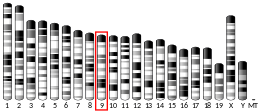Sialin
Sialin, also known as H(+)/nitrate cotransporter and H(+)/sialic acid cotransporter, is a protein which in humans is encoded by the SLC17A5 gene.[5][6][7]
Clinical significance
A deficiency of this protein causes Salla disease.[7][8] and Infantile Sialic Acid Storage Disease (ISSD).
The gene for HP59 contains, entirely within its coding region, the Sialin Gene SLC17A5. Member 5, also known as SLC17A5 or sialin is a lysosomal membrane sialic acid transport protein which in humans is encoded by the SLC17A5 gene on Chromosome 6[9][10][11]
gollark: I can actually do a bit of code sharing between the client and server code which is neat.
gollark: Although I think it would be in python too because... python bad?
gollark: You see, in JS even something like "using an undefined variable" is a *runtime* ReferenceError.
gollark: I actually use TypeScript without even... writing types... the majority of the time, because it means I actually get working autocomplete, and my IÐE will detect errors which for some insane reason JS only notices at runtime.
gollark: TS has compilation anyway, it basically just involves removing the type annotations (this is actually separate from the typechecking).
See also
References
- GRCh38: Ensembl release 89: ENSG00000119899 - Ensembl, May 2017
- GRCm38: Ensembl release 89: ENSMUSG00000049624 - Ensembl, May 2017
- "Human PubMed Reference:". National Center for Biotechnology Information, U.S. National Library of Medicine.
- "Mouse PubMed Reference:". National Center for Biotechnology Information, U.S. National Library of Medicine.
- "Entrez Gene: SLC17A5 solute carrier family 17 (anion/sugar transporter), member 5".
- Haataja L, Schleutker J, Laine AP, Renlund M, Savontaus ML, Dib C, Weissenbach J, Peltonen L, Aula P (June 1994). "The genetic locus for free sialic acid storage disease maps to the long arm of chromosome 6". Am. J. Hum. Genet. 54 (6): 1042–9. PMC 1918202. PMID 8198127.
- Verheijen FW, Verbeek E, Aula N, Beerens CE, Havelaar AC, Joosse M, Peltonen L, Aula P, Galjaard H, van der Spek PJ, Mancini GM (December 1999). "A new gene, encoding an anion transporter, is mutated in sialic acid storage diseases". Nat. Genet. 23 (4): 462–5. doi:10.1038/70585. PMID 10581036.
- Mitchell, Richard Sheppard; Kumar, Vinay; Robbins, Stanley L.; Abbas, Abul K.; Fausto, Nelson (2007). "Table 7-6". Robbins basic pathology (8th ed.). Saunders/Elsevier. ISBN 978-1-4160-2973-1.
- https://www.ncbi.nlm.nih.gov/nuccore/224514687?report=graph&from=12483827&to=12483911
- "Entrez Gene: SLC17A5 solute carrier family 17 (anion/sugar transporter), member 5"
- Haataja L, Schleutker J, Laine AP, Renlund M, Savontaus ML, Dib C, Weissenbach J, Peltonen L, Aula P (1994). "The genetic locus for free sialic acid storage disease maps to the long arm of chromosome 6". American Journal of Human Genetics. 54 (6): 1042–9. PMC 1918202. PMID 8198127.
Further reading
- Lemyre E, Russo P, Melançon SB, et al. (1999). "Clinical spectrum of infantile free sialic acid storage disease". Am. J. Med. Genet. 82 (5): 385–91. doi:10.1002/(SICI)1096-8628(19990219)82:5<385::AID-AJMG6>3.0.CO;2-3. PMID 10069709.
- Winchester BG (2001). "Lysosomal membrane proteins". Eur. J. Paediatr. Neurol. 5 Suppl A: 11–9. doi:10.1053/ejpn.2000.0428. PMID 11588980.
- Mancini GM, Beerens CE, Aula PP, Verheijen FW (1991). "Sialic acid storage diseases. A multiple lysosomal transport defect for acidic monosaccharides". J. Clin. Invest. 87 (4): 1329–35. doi:10.1172/JCI115136. PMC 295166. PMID 2010546.
- Cameron PD, Dubowitz V, Besley GT, Fensom AH (1990). "Sialic acid storage disease". Arch. Dis. Child. 65 (3): 314–5. doi:10.1136/adc.65.3.314. PMC 1792249. PMID 2334213.
- Tondeur M, Libert J, Vamos E, et al. (1983). "Infantile form of sialic acid storage disorder: clinical, ultrastructural, and biochemical studies in two siblings". Eur. J. Pediatr. 139 (2): 142–7. doi:10.1007/BF00441499. PMID 7151835.
- Schleutker J, Laine AP, Haataja L, et al. (1995). "Linkage disequilibrium utilized to establish a refined genetic position of the Salla disease locus on 6q14-q15". Genomics. 27 (2): 286–92. doi:10.1006/geno.1995.1044. PMID 7557994.
- Berra B, Gornati R, Rapelli S, et al. (1995). "Infantile sialic acid storage disease: biochemical studies". Am. J. Med. Genet. 58 (1): 24–31. doi:10.1002/ajmg.1320580107. PMID 7573152.
- Haataja L, Schleutker J, Laine AP, et al. (1994). "The genetic locus for free sialic acid storage disease maps to the long arm of chromosome 6". Am. J. Hum. Genet. 54 (6): 1042–9. PMC 1918202. PMID 8198127.
- Verheijen FW, Verbeek E, Aula N, et al. (1999). "A new gene, encoding an anion transporter, is mutated in sialic acid storage diseases". Nat. Genet. 23 (4): 462–5. doi:10.1038/70585. PMID 10581036.
- Aula N, Salomäki P, Timonen R, et al. (2000). "The spectrum of SLC17A5-gene mutations resulting in free sialic acid-storage diseases indicates some genotype-phenotype correlation". Am. J. Hum. Genet. 67 (4): 832–40. doi:10.1086/303077. PMC 1287888. PMID 10947946.
- Fu C, Bardhan S, Cetateanu ND, et al. (2002). "Identification of a novel membrane protein, HP59, with therapeutic potential as a target of tumor angiogenesis". Clin. Cancer Res. 7 (12): 4182–94. PMID 11751519.
- Biancheri R, Verbeek E, Rossi A, et al. (2003). "An Italian severe Salla disease variant associated with a SLC17A5 mutation earlier described in infantile sialic acid storage disease". Clin. Genet. 61 (6): 443–7. doi:10.1034/j.1399-0004.2002.610608.x. PMID 12121352.
- Aula N, Jalanko A, Aula P, Peltonen L (2003). "Unraveling the molecular pathogenesis of free sialic acid storage disorders: altered targeting of mutant sialin". Mol. Genet. Metab. 77 (1–2): 99–107. doi:10.1016/S1096-7192(02)00124-5. PMID 12359136.
- Martin RA, Slaugh R, Natowicz M, et al. (2004). "Sialic acid storage disease of the Salla phenotype in American monozygous twin female sibs". Am. J. Med. Genet. A. 120 (1): 23–7. doi:10.1002/ajmg.a.10246. PMID 12794687.
- Aula N, Kopra O, Jalanko A, Peltonen L (2004). "Sialin expression in the CNS implicates extralysosomal function in neurons". Neurobiol. Dis. 15 (2): 251–61. doi:10.1016/j.nbd.2003.11.017. PMID 15006695.
- Landau D, Cohen D, Shalev H, et al. (2005). "A novel mutation in the SLC17A5 gene causing both severe and mild phenotypes of free sialic acid storage disease in one inbred Bedouin kindred". Mol. Genet. Metab. 82 (2): 167–72. doi:10.1016/j.ymgme.2004.03.005. PMID 15172005.
This article incorporates text from the United States National Library of Medicine, which is in the public domain.
This article is issued from Wikipedia. The text is licensed under Creative Commons - Attribution - Sharealike. Additional terms may apply for the media files.




